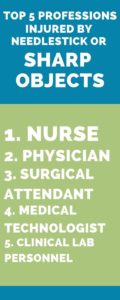Unsafe practices mean 32% of physicians and nurses sustain exposures to infectious disease


As a woman-led advocacy organization, International Safety Center’s mission is the safety of all health professionals around the globe. “Our vision at the International Safety Center is a future where there are zero illnesses or infections associated with occupational exposure to infectious disease,” says Dr. Amber Hogan Mitchell, the Center’s President and Executive Director. “This will take careful, ongoing attention to incident surveillance and a full understanding of the circumstances surrounding exposures so we can work collaboratively, putting controls in place, to prevent them.”
Nurses are most frequently injured with disposable hypodermic syringes in patient and exam rooms and physicians are most frequently injured in operating and surgical settings when using sutures (45.5%) and scalpel blades (10.6%). Physicians are more likely not to use devices with sharps injury prevention (SIP) features, in fact they report using SIPs only 6.3% of the time during an injury. Of the 32% of injuries sustained by physicians, 72.9% occurred in the operating room and surgical environments.
Given that sharps injuries occurring in surgical settings are not only high-risk injuries to the users themselves, but also to their surgical teams due to unsafe practices like hand-to-hand instrument passing or improper disposal, and can result in harm to the patient, the Center focused on updating its OR-specific EPINet Surveillance Database and Report Forms. Members from several clinical organizations including AORN, ANA, and ACS reviewed the forms and expressed how crucial these will be for protecting operating room personnel. The current EPINet database is free for any facility to use anywhere in the world.
EPINet Reports document an unacceptably high incidence of blood and body fluid splatter to unprotected eyes (48.1%). Incidents reported that only 3% indicate that they are wearing protective eyewear (eyeglasses with sideshields, protective eyewear, or faceshields). This is like saying only 3% of car drivers were wearing a seatbelt during a motor vehicle accident.
Blood splatters carry extraordinary risk given that not only bloodborne pathogens, but infectious diseases including flu, TB, and superbugs like MRSA transmit via this route. More must be done to improve accessibility to protective eyewear in locations where it is needed, including patient and exam rooms. Healthcare organizations, including medical device and equipment manufacturers, must improve access to protective technologies and procedures.
The Center took over management of TDICT – Training for the Development of Innovative Control Technologies – an organization spearheaded by Dr. June Fisher, a long-time tireless advocate for the safety and health of workers. Thousands of healthcare facilities around the globe have used the TDICT Medical Device Evaluation Forms.
Since employers in the US are required to have non-managerial frontline employees evaluate, select, and implement engineering controls including devices with sharps injury prevention (SIP) features, these forms are valuable tools for those evaluations. To join in support of safer devices and procedures, visit https://internationalsafetycenter.org/about/contact-us/.
